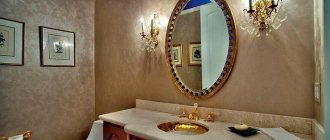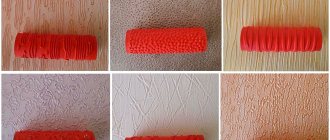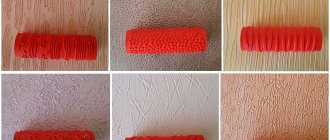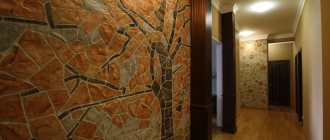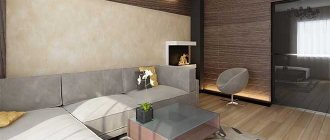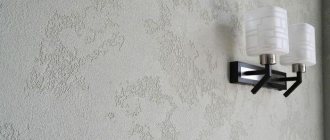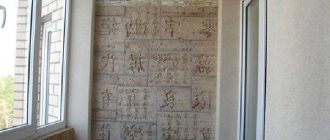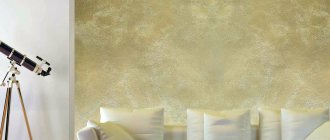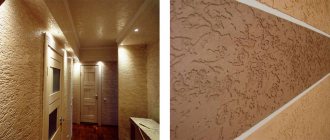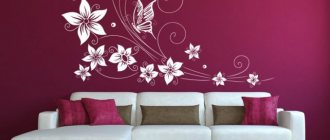Methods for creating decorative relief
The method of applying structural plaster depends on its type and the desired effect. To work you will need the following equipment:
- tank for diluting the mixture;
- trowel, trowel, scraper;
- spatulas of different types;
- brushes, rollers, brushes, combs;
- mixer.
Please note: regardless of the type of plaster applied, the surface underneath must first be cleaned, leveled and primed.
Instructions on how to apply “bark beetle”, structural plaster with your own hands - video:
https://youtube.com/watch?v=KhGsjhz_i-M
Spray method
Plaster is applied using a broom and stick. They hold a broom in one hand and a stick in the other. The tip of the broom is dipped into the solution, and then it is hit on the stick so that the splashes hit the wall. Spraying is done in 2 layers.
An example of how to make a “fur coat” structure with an ordinary broom
Creating relief with a trowel
First, a continuous base layer of plaster is applied to the entire surface. When it dries, begin to apply the second layer, immediately forming patterns by moving the trowel in different directions. An example of how to apply structural plaster in the video:
Creating structure with a brush
A metal brush is brushed over the freshly applied layer of plaster, forming thin chaotic lines. When the coating is dry, remove small particles from it with a soft brush.
this structure is also called “bouffant”.
A simple technique for creating a “bouffant” relief - do-it-yourself structural plaster, photo
Stamping using a roller
Another way to get an interesting structure is to use a relief roller. It can be sold with a ready-made pattern, or you can create the texture yourself.
Idea: if you wrap a roller with thick threads, when applied, the plaster will imitate grass stems.
Technology of structural plaster relief “grass” using a roller:
https://youtube.com/watch?v=5x13yW9lvPM
There are many ways to apply relief. Would you like to learn more about how structural plaster is applied? Video tutorials will help you with this:
Application technologies
There are many techniques for applying the mixture, for example, bark beetle, fur coat, spraying and others. Let's consider the technology for correctly applying bark beetle plaster with structural plaster for external wall decoration:
- Clean the surface. Remove remnants of previous putty, paint and other finishing materials.
- We level the surface from large cracks, chips and other defects.
- Apply two layers of primer, letting them dry one at a time.
- After complete drying, apply the plaster by throwing it using a spatula.
- Immediately we begin to plaster the wet mixture and level it with a construction tool - a grater. The pebble material leaves a pattern of termite-eaten bark by leaving indentations. 1-2 layers of putty are enough here.
- The material does not require further opening with wax or varnish, but can be painted in the desired color. You can use a paint gun.
Structural plaster is a popular method of finishing walls. You can do this yourself or by calling a professional. The applied pattern is unique, so this is a great opportunity to create a unique design.
Making your own mixture
If you don’t want to spend money on a finished product, you can make structural plaster for interior work with your own hands.
To prepare a composition with a pronounced structure, prepare the following materials:
- 6 kilograms of dry putty;
- 2 liters of water;
- 0.2 kg of glue-plasticizer;
- fillers (to choose from - pebbles of different shapes and sizes, broken glass, foil, sand, parts of tree bark, beads, etc.).
To prepare the material with your own hands, you need to take a large plastic container and mix dry putty with water in it using a construction mixer. Then add glue and filler there and mix everything well.
If you have no experience working with decorative plaster, it is better to try the prepared composition on one wall in a small room, for example, a small pantry or corridor. If the coating does not look as expected the first time, clean the wall and reapply the layer.
Scope of application
By its nature, structural plaster is a universal type of building material, which allows it to be applied to almost any base. Most often this is:
- metal;
- concrete;
- tree;
- plasterboard sheets.
The mixture adheres to both vertical and horizontal surfaces. Suitable for finishing building facades and plinths. As for the interior, this is a good choice in favor of halls, living rooms, hallways, and corridors.
Structural plaster is used for both interior and exterior decoration
Peculiarities
Relief structural plaster is a universal finishing material, because, thanks to the variety of possible design solutions, it will fit into almost any interior style. The properties of plaster are such that it is suitable both for residential premises and for finishing walls in the bathroom, kitchen and for cladding the facades of buildings.
A distinctive feature of structural plaster is that it can be applied to any wall base. It can be drywall, concrete, brick, wood or metal, the main thing is to choose the right composition of the finishing material, or rather the type of binder.
To apply relief plaster, you do not need to carefully prepare the base, since, thanks to its structure, it perfectly masks small defects.
The advantages include:
- waterproof;
- easy to maintain, can be washed with water or any detergent, except solvents;
- tolerates temperature changes well;
- plastic material that allows you to create various decorative effects;
- high vapor permeability due to microporosity;
- durability;
- relatively low cost.
The only downside to this type of wall covering is the difficulty of dismantling. If you decide to change the finish, it will not be easy to remove the decorative plaster, after which you will need to restore and level the wall surface.
Why does decor need structure?
Structural plaster is a multicomponent construction compound intended for decorative wall finishing.
Each manufacturer means by this term its own understanding of the structure. Some of them evaluate the solution by the resulting texture on the wall, others evaluate the quality of the original composition. Regarding the second, they argue that such plaster is a heterogeneous solution, consisting of fractions of different quality characteristics. These include:
- inclusion cross-section (mm);
- fraction source material;
- granule shape;
- origin of components.
Others, regardless of the internal structure, attach more importance to the external manifestation of the composition on the wall. The same structural plaster for interior work, after application to the surface, can take on absolutely any shape. It all depends on the impact received.
This approach is interesting from an aesthetic point of view, since it allows you to create and create new options each time, modeling the connection in a different way. Therefore, the answer is obvious - the structure allows you to create a unique design. This is actively used by real craftsmen, but given the high cost of the working material, there are not many of them.
Application methods and tools
Structural plasters are applied to a clean, dry surface. The thickness of the layer is selected individually, from 2 to 20 mm, depending on the quality of the base and the granularity of the solution. For a thick finishing layer, for example on facades, small unevenness and cracks do not need to be straightened. Structural plaster technology requires mandatory priming of surfaces; a deep penetration mixture is recommended.
Important: If the structural plaster is tinted before application, then it is necessary to prepare the base. Usually these are 2 layers of opaque gray primer or the color of the mixture.
Tools and techniques for applying structural plaster
We have already described above how the texture of a fur coat is made. Let's consider other popular ways to create a beautiful relief surface.
To achieve the Traventino texture, the mixture is applied with a stainless steel trowel. The first layer is even and smooth. After drying, apply the second layer in small, skipped strokes. After 15 minutes, the cakes are leveled and, as it were, pulled out with a trowel. Watch the lesson on how to properly smooth out structural plaster; the video explains all the nuances of creating a pattern to look like natural stone. For greater naturalness, grooves can be made using the template to imitate masonry.
To create a bark beetle structure, plaster is applied in an even layer, with a thickness equal to the grain size of the inclusions. Without allowing the layer to dry, we treat the coating with a circular motion with a trowel.
With this technique, grains are drawn behind the instrument, forming characteristic grooves.
Rain drawing is best done with a medium-grain solution. The mixture is applied in neat strips diagonally, each layer slightly overlapping the previous one. When the solution has set, the coating is also leveled diagonally with a trowel and rubbed until grooves are formed.
The process of applying plaster with the “Rain” effect
To achieve other decorative effects, you should be creative, for example, leveling the mortar with a trowel vertically, horizontally, or in checkerboard strokes.
We will separately tell you about the possibilities of structural plaster when applying designs using improvised materials, rollers, brushes and even your hands. Here the imagination is not limited in any way, but for such work it is better to use thin and fine-grained, almost homogeneous solutions.
https://youtube.com/watch?v=RecbA_0O7lM
The principle of a textured coating is simple: first, a base, even layer of plaster is made, and the selected pattern is drawn on it using tools:
- A brush with stiff bristles – furrows, imitation of a woven surface, folds of fabric, waves.
- A roller with a medium coat helps create the texture of the rock.
- A structural roller for decorative plaster can have any pattern, from floral to abstract; the variety is so great that the choice depends only on your preferences. In order not to buy a tool in a store, you can wrap a rope, polyethylene, or fabric around a regular roller.
- Sponges, crumpled paper, polyurethane stamps, stencils are a great opportunity to create your own individual pattern on structural plaster.
Good to know: To obtain a coating with a silk plaster effect, the instructions require the use of thin solutions; after application and drying, the surface must be thoroughly sanded and ironed.
We offer you several original ways to make structural plaster; video lessons will push you to creativity and teach you simple, but effective and beautiful decorating techniques.
After the solution has dried, the surface must be sanded, if necessary, painted and covered with a protective layer. For glazing, wax or water-based acrylic varnish is usually used, in 2 layers.
Necessary tools for work
Before you start finishing, you need to prepare for the process. For the main stage of work you will need the following list of tools and devices:
- spatulas of different sizes;
- rollers;
- brushes;
- sponges;
- metal trowel;
- rule;
- building level;
- masking tape;
- rags.
Tools for applying decorative plaster
These items will be useful in creating the desired relief:
- structural roller with a fur coat;
- porous foam rubber, polyethylene film;
- notched spatula;
- silicone molds;
- a broom made of twigs;
- a brush with stiff bristles.
It’s easier with ready-made solutions - all you have to do is stir the mixture and you can start working. But if you buy dry powder, then you need a suitable container (optimally a plastic basin), as well as a construction mixer or an electric drill with a special attachment.
It is better to dilute dry compounds using a drill with a special attachment or a construction mixer
At the finishing stage, the main role is given to the spatula and trowel. Only stainless steel tools are suitable for working with stone materials. They do not leave black marks during grouting and ironing operations.
Spatulas and graters for applying the mixture should only be selected with rounded edges.
Types of decorative plaster
• Conventionally, the following types of decorative plaster can be distinguished: • Structural; • Textured; • Venetian; • Decorative plaster for exterior decoration of building walls.
Structural decorative plaster
This type of decorative plaster is characterized by the presence of elements in the plaster mixture that add volume and unevenness. Such elements can be: • Stone chips; • Glass chips; • Metal shavings; • Polymer volumetric elements of various sizes.
When applied, such decorative plaster is characterized by a minimum number of operations and construction tools required for work. You can purchase ready-made structural plaster at a construction hypermarket or prepare it yourself with your own hands.
Textured decorative plaster
The composition of the mixture for preparation can be homogeneous or include structural components. Unlike structural decorative plaster, the texture is created not by the color and size of the structural components, but as a result of the use of various tools used in the application process.
The work of creating the required texture is more difficult than applying a layer of structural plaster and requires certain skills in plastering and painting. But, thanks to the high plasticity of plaster mixtures during the work process, it is quite easy to correct flaws and shortcomings by applying a second or third layer of plaster or subsequent painting, masking deficiencies in the application of plaster.
Venetian plaster
The most highly decorative type of plaster, allowing you to imitate the texture of natural stone (marble). Create interiors with phosphorescent, pearlescent, artificially “aged” surfaces.
The technique of applying Venetian plaster is the most complex. It is not worth doing important work with your own hands without sufficient experience. To master the technique of applying decorative plaster, you should practice on simpler options - structural or textured decorative plaster.
Decorative plaster for exterior wall decoration
In terms of its composition and application technique, it has the same characteristics as the decorative plasters discussed above for interior decoration.
It is distinguished from the former by a composition with increased moisture resistance, resistance to temperature changes, and resistance to fading under the influence of sunlight. This type of plaster is characterized by a rough (coarse-grained) structure, which requires great physical effort during manual application and the use of special construction tools to create a more voluminous texture that will be clearly visible on the facade of the building.
Choice
Let’s take a moment to understand the wording a little. Structural plaster is a colorless composition in which lime, cement, acrylic or latex acts as a base, water or a chemical solvent as a diluent, and wood fibers, pieces of stone, quartz or mica as a decorative filler:
Schematic representation of the composition of structural plaster
The solution is colored using special color additives or by applying paint after it has hardened.
Applying paint to a colorless layer of structural plaster
Advice: if you want to make the plaster mixture colored, it is recommended to order tinting using special equipment. Firstly, in this case you can choose any shade you like, and secondly, you can repeat it if necessary, which is almost impossible when mixing by hand.
Tinting studio, professionally engaged in imparting color to finishing materials
Structural plaster becomes textured after application and giving it an appropriate relief surface. It can also be called decorative, which is simply a general concept that includes many different solutions and cladding techniques. So don’t be too surprised by such definitions from sellers; they don’t really change the meaning.
There are many offers from various brands. For example, in my search for a suitable solution I came across the following options:
Structural decorative plaster "Stone"
A sample of “Stone” structural plaster applied to a wall
These products are represented by the famous brand “Dessa-Decor”, but are manufactured in Russia. It perfectly imitates limestone, tufa, and masonry, living up to its name, which means “stone” in English.
Advice: if you need to finish a newly built house that has not yet gone through all the shrinkage processes, it is recommended to use Stone plaster, since it contains fiber fibers, which give it high elasticity.
Technical description:
| Characteristic | Meaning |
| Density | 1600 kg/m3 |
| Approximate consumption | 1.6-2.4 kg/m2 |
| Possible packaging | Buckets weighing 15 kg and 30 kg |
| Operational life | More than ten years |
| Curing period | 12 hours |
| Strength gain | Month |
| Processed surfaces | Plaster, concrete, plasterboard sheets, particle board, fiber board and others |
| Application area | Walls, ceilings, columns and other architectural elements |
| Price of a bucket weighing 15 kg | 2940 rubles |
Wet cleaning can be done within two weeks after application. The finished coating is environmentally friendly and does not contain any allergens.
Structural decorative plaster "Bark beetle"
Structural bark beetle plaster applied to the wall
The secret of decorative bark beetle plaster is the presence of marble chips in the mixture itself. Thus, in the process of facing work, by grouting the not yet dried layer, characteristic grooves are scratched out, reminiscent of traces of the activity of the bark beetle in the wood. The result is quite unique and attractive.
Here my attention was attracted by the offer of the Ceresit brand, which is very widespread on the domestic market, a ready-made acrylic mixture ST 64, which has the following technical description:
| Characteristic | Meaning |
| Density | 1700 kg/m3 |
| Approximate consumption | 2.6 kg/m2 |
| Packing | 25 kg |
| Drying period | 15 minutes |
| Grain | 2-3 mm |
| Application area | Internal and external works |
| Price per bucket weighing 25 kg | 1773 rubles |
Sample of a fifteen-kilogram bucket with structural plaster “Bark beetle” of the Ceresit brand
The use of acrylates guarantees high strength qualities and the absence of any toxins during the drying process of the layer.
Structural decorative plaster “Wet silk”
Containers with “Wet Silk”
If the imitation of stone was expected, and you can imagine walls corroded by bark beetles, then the cladding under fabric with mother-of-pearl particles still made even me surprised. For my parents, this, of course, would be too extravagant, but I did not deny myself the pleasure of taking a closer look at such material:
| Characteristic | Meaning |
| Approximate consumption | 150-300 g/m2 |
| Packing | 1-6 kg |
| Drying period |
|
| Color | White |
| Processed surfaces | Plaster, concrete, plasterboard sheets, asbestos cement and others |
| Application area | Interior |
| Price per container weighing 6 kg | 1550 rubles |
“Wet silk” on the wall looks amazing
This plaster tolerates washing well and can be used in rooms with extremely high humidity.
Structural decorative plaster "Travertine"
Sample of a wall covered with Travertine
This facing material has a very strong external resemblance to limestone rock. It is created on the basis of modified acrylic polymers and a special mineral filler.
Has high performance characteristics:
- Prevents the formation and spread of fungi;
- Does not absorb aromas;
- Easily restored;
- Has a very long service life;
- It has such high strength that pets can even sharpen their claws on it without causing damage.
In my situation, I paid special attention to the last point.
Technical description:
| Characteristic | Meaning |
| Brand | "Derufa" (Germany) |
| Binder | Acrylic polymers |
| Diluent | Water |
| Density | 1500 kg/m3 |
| Approximate consumption | 550 grams per square meter |
| Abrasion resistance | 10000 |
| Packing | 3 kg or 15 kg |
| Drying period | · Partial – 9 hours; Full – three days |
| Price per package weighing 15 kg | 4590 rubles |
Container with Travertine plaster
Structural decorative plaster “Encausto Fiorentino”
Coating with Encausto Fiorentino with marble effect
Thanks to the latest technologies, the ancient recipe is back in trend and allows you to create semi-matte marble cladding for both the internal and external walls of your home.
Compound:
- Aged lime milk;
- Treated lime filler;
- Toxin-free supplements.
When slaked lime, which forms the basis of this product, comes into contact with carbon dioxide, which is abundant in the air around us, a carbonization process occurs, guaranteeing a durable coating.
Technical description:
| Characteristic | Meaning |
| Specific gravity | 1.7 kg/l with an error of 1% |
| Viscosity | Highly thixotropic paste |
| Drying period | · Partial – 120 minutes; · Full – 24 hours |
| Approximate consumption | 0.9 liters per square meter |
| Packing | Packaging weighing 23 kg |
| Application area | Internal and external walls |
| Price per package weighing 23 kg | 6600 rubles |
An excellent way to “dress” a house in marble, which, as a rule, is chosen by people who want to emphasize their status and wealth.
"Encausto Fiorentino" in the interior of a country cottage
Structural decorative plaster "Decor"
Pack of "Decor" weighing 25 kg
Sold as a dry mixture based on white cement, modified with polymer additives.
Technical description:
| Characteristic | Meaning |
| Brand | "AliMix" |
| Manufacturer country | Uzbekistan |
| Packing | Packaging weighing 25 kg |
| Application area | Internal and external wall cladding |
| Color | White |
| Mixing Recommendations | 1 kg of mixture per quarter liter of water |
| Drying period |
|
| Maximum applied layer thickness | 0.5 cm |
| Approximate consumption | 3.5 kg per square meter |
| Adhesion force to the base | 0.5 MPa |
| Shelf life | 9 months |
Advice: if you do not plan to use the dry mixture immediately after purchase, it is recommended to store it in a dark, dry place. The presence of dampness can cause a petrification process, which will make the product unsuitable for application.
Structural decorative plaster “Alpina Strukturpulz K15 Lamb”
Bucket with ready-made mixture “Alpina Strukturpulz K15 Lamb”
This is an example of dispersion plaster, which has the following technical description:
| Characteristic | Meaning |
| Brand | "Alpina" |
| Packing | Container weighing 16 kg |
| Fraction size | 1.5 mm |
| Approximate consumption | 2.6 kg per square meter |
| Areas of use | Internal and external finishing works |
| Processed surfaces | Thermal insulation systems, concrete, putty, old dispersion-type paints and varnishes |
| Price per container weighing 16 kg | 1550 rubles |
Texture of “Lamb” applied to the wall
This option is quite convenient in that it does not require the use of special technologies to form the texture of the applied cladding. “Lamb” is already unusual in itself, but on the other hand, it’s not to everyone’s taste.
Structural decorative plaster "Breeze"
Airtight container with "Breeze"
This finish is suitable exclusively for interior work. Due to its attractive appearance, ease of use and acrylic base, which guarantees environmental friendliness, it is very often used to decorate the walls of offices and shops. But for home use this option is quite expensive.
“Breeze” looks great on the wall
Technical description:
| Characteristic | Meaning |
| Brand | "Irkom" |
| Application area | Interior finishing work |
| Packing | Container weighing 4.5 kg |
| The basis | Acrylic |
| Price per container weighing 4.5 kg | 17130 |
Structural decorative plaster “Diamant-260”
Packaging containing Diamant-260 plaster
Another very famous one offers white mineral structural plaster on a lime-cement base with polymer additives. During application, such a solution creates a uniform granular coating in the form of a fur coat.
Technical description:
| Characteristic | Meaning |
| Brand | "Knauf" |
| Country of manufacture | Russia |
| Areas of use | External and internal finishing works |
| Density | 1550 kg/m3 |
| Grain diameter | 3 mm |
| Compressive strength | 4.3 MPa |
| Flexural strength | 2.7 MPa |
| Thermal conductivity | 0.86 W/(m×K) |
| Approximate consumption | 37 kg per square meter |
| Price for a 25 kg package | 350 rubles |
Structural compositions
Despite the different names, the composition of this type of decorative plaster remains virtually unchanged. It can be based on gypsum, cement, lime or combinations thereof. The filler can be yellow river sand, flour or crumbs from various types of natural stones, for example, marble, granite, quartz and so on. Optionally, polymer additives are added to the mixture to increase viscosity, antiseptic and moisture-resistant components.
The structure of the surface after drying directly depends on the type, quality and fraction of the filler. For example, the most common structural bark beetle plaster may contain grains with a diameter of 1.5 to 5 mm. Several dispersed materials with different sizes are added to the “lamb” mixture.
Structural plaster
Making your own gypsum plaster
Gypsum decorative plaster is used most often. It dries quickly, is easy to apply and level. There are two main options for its preparation:
- Simple. It consists of dry gypsum flour and lime dough. These materials are mixed in proportions 1:3, and then diluted with water. The liquid must be poured gradually until the consistency of the solution resembles thick sour cream. At the end, color is added if necessary.
- With the addition of silicate material. The basis of the material is the same as in the first option, but liquid glass is additionally added. First, mix the basic materials in proportions of 1:3.5, then add silicate (about 5% of the mixture weight) and dilute with water.
In order for gypsum plaster to be plastic, all proportions must be strictly observed.
Gypsum mixtures are suitable for finishing work only in dry rooms; you can decorate both walls and ceilings.
Cement-sand mixture
A cheaper and more durable material is cement-sand mortar. To prepare it, cement, sand and slaked lime are mixed in proportions 1:2:1, after which silicate material is added (5% of the total mass). At the end the mixture is diluted with water. The consistency should be such that it is convenient to scoop the material onto a spatula, but not too liquid, it should not drain from the surface.
The cement-sand mixture is quite easy to prepare yourself.
The very last step in preparing structural plasters is the addition of stone chips. Let us remind you that its content should not exceed 70%.
If the question arises of how to make decorative plaster quickly and inexpensively, then the easiest option would be to purchase a ready-made mixture, without natural stone additives, and a separate filler. Even if a ready-made mixture is purchased, the cost will still be lower than a structural composition with filler already included in it. To prepare a mixture of such components, you just need to add flour or crumbs to the mixture and dilute it with water.
How to choose the right building mixture
First of all, craftsmen focus on price when purchasing decorative plaster. But this is not the main selection criterion. It is advisable to focus on the following parameters:
- Type of mixture according to the type of base. Some of them can be laid on standard unprepared walls. And some require only a carefully prepared foundation.
- Room humidity level. It is better to take silicate varieties for the kitchen and bathroom. They repel water.
- Breathability. It is desirable that the living room under the layer of plaster still “breathes”. This will ensure a normal indoor microclimate.
And be sure to correctly calculate the volume of plaster for your area in order to purchase the mixture from one batch. If you then purchase additional plaster from another batch, there is a high risk of shade differences (for colored mixtures).
Relief paintings from plaster and bas-reliefs in a modern interior
With the help of structural plaster for walls, more complex finishing options are created, using it to create relief paintings. This finishing method is one of the most complex and requires not only construction skills, but also the talent of an artist. Using the plasticity of the plaster mortar, pictures with many different elements are painted on the surface to be finished. Compositions that use separately created molded volumetric elements look very interesting, giving the composition a special flavor.
The originality of such bas-reliefs is given not only by the texture of the plaster, but also by the coloring. With a monochrome solution, various shades and halftones are used, making the bas-relief image more saturated. Using 2-3 colors for decoration makes the composition more interesting, and multi-color design allows you to create real masterpieces of interior decoration. Of course, the technique of execution is quite complex, but the effort expended is justified by the result achieved.
Types of coatings with pronounced relief
Structural plaster is a heterogeneous composition of a granular nature, containing various fillers (quartz sand, mica, stone chips, wood fibers). It is used to give the surface a decorative appearance.
Thanks to various technologies for applying structural coating, it looks harmonious in the interior of any room.
The plaster mass is made on the basis of a cement-lime composition, synthetic components, and silicates. In appearance, the structural coating is a white plastic mass. The mixture is applied to the walls in a layer of a certain thickness, and then processed with special tools until the required pattern is formed.
Examples of wall relief - different mortar application technologies
Structural plaster for facades is a moisture- and weather-resistant coating, resistant to abrasion, designed specifically for decorating the external walls of a building and basement. It is made on the basis of dispersion, silicone resins, silicates, or mineral additives. The coating can be applied to brick, aerated concrete, concrete, plaster using a brush, spatula, or roller. Its varieties are mineral plaster, “bark beetle”, “crocodile”, “lamb”.
high-quality structural plaster for external use retains its decorative and protective properties for up to 10 years.
Decorative structural plaster for exterior decoration of a building does not fade, and the color of the coating can be changed over time
Structural plaster for interior work is a thin-layer coating that is applied to brick, concrete, wooden walls, and drywall. It allows the walls to “breathe”, can be cleaned and washed, and is easy to maintain.
Modern decorative mixtures can imitate almost any coating, from tree bark to snakeskin, silk linen, torn stone, marble (Venetian). More information about how to apply silk plaster - instructions:
https://youtube.com/watch?v=IbrcMqCGbpM
Making your own solution
The mixture, which can be used to decorate walls and ceilings, is sold ready-made, or you can prepare it yourself. How is structural plaster made?
At home, you can prepare your own mixture for textured finishing from simple building materials. To do this you need:
- 6 kg of dry putty;
- 200 g glue;
- 2 liters of water.
First, mix putty and water. Then glue is poured into the solution, mixed and applied to the surface. A pronounced surface texture will result from the addition of a certain fraction of filler to the mixture. To imitate sandstone, a grain of 0.3 mm is used; the pattern of wild stone is recreated using filler with a fraction of 1.5 mm. For bark beetle plaster, 2 mm grains are used, and to create the effect of tree bark - 3 mm.
Important: the ratio of filler to binder (gypsum, glue) is 3:1.
A simple way to create a relief using a structural roller for decorative plaster
Preliminary preparation of the wall surface
Structural plaster is applied only to a prepared and level base. The essence of this stage is to clean the surface of the old finish. To do this, different techniques are used, depending on the type of material:
| Paint can be removed with a spatula or grinder. In rare cases, an acid wash is carried out or the wall is heated with a hair dryer. | |
| Lime, gypsum plaster - the coating is moistened with a vinegar solution and then knocked off with a chisel. | |
| Wallpaper - just moisten it with a damp cloth and peel it off with a spatula. In other cases, treatment with acid or steam helps. |
Deep unevenness is filled with starting putty, after which the serpyanka is laid and covered with a second layer of the mixture. The same composition closes small cracks. When identifying pockets of mold or mildew, be sure to cover the surface with an antiseptic primer, applying 2 layers and waiting for each to dry.
In case of severe curvature, the walls are sheathed with sheets of plasterboard.
Textured plasters
In this case, we are talking about a material that contains fine-grained fillers, so after drying a smooth surface is formed. The plaster received this name due to the fact that before setting, various relief patterns are applied to the surface using floats, half-graters, trowels, figured spatulas, brushes and rollers. The advantage of textured plasters over structural ones is that the master has the opportunity to implement his own design solutions. At the same time, structural materials are easier and faster to apply.
VIDEO:
Cooking recipes
For wet rooms and outdoor work, cement-based material is used. To a standard bag of cement (weight 50 kg) add 10 kg of ordinary tile adhesive. After this, 0.5 kg of Rotband plasticizer is added to the mixture. Lastly, add water and mix the mixture thoroughly.
For finishing surfaces inside dry rooms, the gypsum option is better suited. To do this, you will need 6 kg of dry ready-made plaster mixture based on gypsum, 200 g of PVA glue and 2 liters of water. The process of making textured plaster with your own hands is somewhat complicated and includes the following steps:
- First of all, 1.5 liters of water are poured into the dry mixture and mixed thoroughly until a homogeneous mass is formed.
- Then PVA glue is added to the remaining water and mixed as well.
- At the end, you need to make a homogeneous mass from the two mixtures, its consistency should resemble thick sour cream.
Making your own solution from gypsum plaster, PVA glue and water
Also, do-it-yourself decorative plaster is made on the basis of white Portland cement, grade no lower than 400. The most popular recipes for making 1 kg of such mixtures:
- 200 g of lime dough are mixed with 740 g of marble flour and 50 g of cement, at the end 10 g of manganese peroxide and a little water are added.
- 630 g of white sand, 150 g of crushed brick, 50 g of cement and 150 g of lime dough are mixed and 20 g of water are added.
- 180 g of marble flour, 600 g of lime sand, 80 g of cement and 120 g of lime dough are mixed and 20 g of water are added.
Advantages and disadvantages
When choosing any building material, it is important to consider not only the advantages - the disadvantages also deserve attention. This allows you to better understand which option is suitable for current operating conditions. Among the advantages, it is worth highlighting these advantages:
- plaster can hide various surface imperfections;
- the coating has a volumetric relief;
- It is permissible to carry out wet cleaning and disinfection with chlorine-based products;
- rich color palette;
- acceptable pricing policy.
The advantages of structural plaster include long service life and beautiful appearance.
Fortunately, there are few disadvantages and the main disadvantage lies in the monolithic nature of the coating, which makes dismantling extremely difficult. If it is necessary to change the finish, you will have to subsequently begin restoring the leveling of the base. Another drawback is its considerable weight (up to 4.5 kg/m2).
Types of plaster
Depending on the base used, structural plasters are divided into the following types:
Mineral
This is the inexpensive, most popular and accessible material. It is produced in dry form, is inexpensive, and is used sparingly. The mixture contains cement or lime. The mineral base of the plaster has excellent permeability and high thermal insulation qualities.
The coating can be applied to any surface. The composition necessarily contains components that prevent the erosion of lime. Surface facades finished with this composition can be easily washed.
Silicate
The silicate composition is highly durable. The main material is liquid potassium glass. This plaster is usually sold ready for use. It is quickly applied and dries, which requires special skill in the process of application and formation of texture. Silicate decorative plaster is valued for its excellent performance, environmental friendliness and good permeability.
Acrylic
The main component of such mixtures are acrylic mixtures. They are elastic and resistant to deformation. Facades decorated with an acrylic plaster layer are easy to clean. Such mixtures are chosen for finishing new buildings. The presence of plasticizers in acrylic plasters preserves the integrity of walls during inevitable shrinkage in new buildings.
Silicone
The basis of this plaster mixture is silicone
Durability is the most important advantage of the material. The silicone composition is odorless, does not fade in the sun and is resistant to temperature changes
All types of structural plaster are distinguished by high plasticity. They are easy to work with; no special knowledge or skills are required. As for choosing the right material, professional advice can help here. It all depends on the complexity of the planned work and your design preferences. Mineral-based and silicate mixtures are more suitable for finishing facades. They look attractive, perfectly insulate and strengthen walls.
Variety of textures
Depending on the plaster filler and application method, the surface may look like:
- sand wall or dunes;
- orange peel;
- luxury tanned or cracked leather;
- fish scales;
- various reliefs;
- reptile skin;
- smooth or fleecy fabric;
- semi-antique;
- cracked stone surface;
- precious stones.
USEFUL INFORMATION: Panoramic window: in an apartment and a private house, pros and cons
Particular sophistication of the interior is provided by bas-reliefs that can be applied to a dried plastered surface.
Features of applying different types of decorative plaster
Each type of plaster requires the use of special tools and application methods, but preparatory work is mandatory for all.
Decorating walls with plaster yourself requires knowledge of how to work with the material.
Preparatory stage
Plastering walls with any type of mixture begins from this stage. To carry it out you will need the following tools and materials:
- sandpaper or sanding machine;
- narrow and wide spatulas;
- paint brush;
- plastic film and masking tape;
- putty and primer.
The first step is to clean the surface from traces of corrosion, paint or wallpaper residues, and also remove all fasteners. Treat the surface with a grinding machine or sandpaper, and then remove the resulting dust with a vacuum cleaner or simply brush it off the walls. Fill the resulting potholes and cracks with putty and wait until it dries.
VIDEO:
To apply decorative plaster, use a wide spatula onto which the solution is scooped. Then it is applied to the walls. Such plasters take a long time to dry, so you can take your time and treat the entire surface at a time. Applying a pattern will require approximately 1.5 mm of material layer, so the thickness of the entire layer should be about 3 mm
At this stage, it is important to achieve complete coverage of the surface with the solution.
Without waiting for the material to dry, proceed to the next stage. To carry it out you will need a brush, rollers of various types or a trowel. Thanks to the relief patterns and irregularities on the surface of this material, texture will appear on the plaster. Which tool to choose and how to use it is a personal matter for each master. The only rule is that you cannot push the solution deeper than 1.5 mm. Otherwise, after drying, the material will not gain strength and will peel off from the walls.
Creating texture on the surface using a brush
A day after completion of the work, the surface is primed, painted and waxed. You will be able to touch it in about 48 hours.
Application of Venetian plaster
Plaster such as “Venetian” is considered a false material that requires professionalism. But still, anyone can do it, the main thing is to follow the instructions below:
- The prepared solution is scooped onto a wide spatula and the surface is leveled with a regular trowel.
- Then they take a special tool - a Venetian trowel and treat the entire surface with it. You need to press the tool with medium force, and the movements should be chaotic.
- Using the same principle, the second and third layers are applied at intervals of 8-10 hours.
- After this, you need to carry out ironing. To do this, a Venetian trowel is pressed firmly against the surface to be treated and “passed” over the entire area until a metallic sheen appears (hence the name of the process).
- Finally, the wall is waxed and polished with a sanding machine with a soft wheel.
VIDEO:
To summarize, we can say that cosmetic repairs in an apartment or house may not cost that much. To do this, you need to try to do most of the processes yourself. Then the repairs made will bring a lot of positive emotions.
Photo gallery: decorative plaster in the interior (16 photos)
Useful tips
Experienced finishers can share valuable recommendations that will help novice craftsmen learn useful skills:
- When preparing, you should use plastic film. After finishing work, it is convenient to roll it up and throw it in the trash container.
- In the absence of experience, it is advisable to choose a simple mixture.
- Water-based plaster must not be applied to wood surfaces.
- If there are a large number of irregularities on the wall, the consumption of the decorative composition increases.
- If partial drying of the surface is required, 4-5 hours is enough. Complete drying takes from 1 to 2 days. It takes 9 days to gain strength.
The average time for complete drying of decorative plaster is from 1 to 2 days
Following the advice allows you to avoid serious mistakes that beginners often make.
Structural plaster mixture is a good choice for finishing interior and exterior surfaces in order to update the interior of the apartment and the exterior of the house. The main thing is to correctly select the composition for the current operating conditions. The work as a whole is not difficult and any beginner can handle it, of course, subject to technology.
